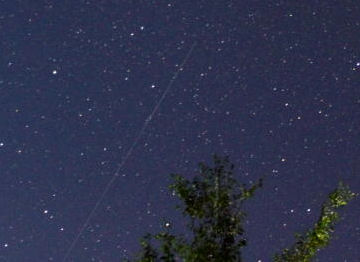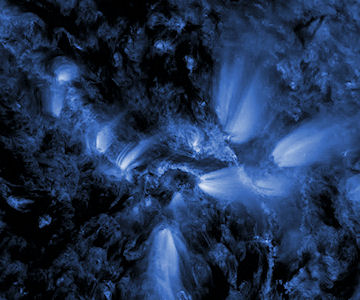NEW AND IMPROVED: Turn your iPhone or iPod Touch into a field-tested global satellite tracker. The Satellite Flybys app now works in all countries. | | | SPACESHIPS IN THE SUN: The ongoing flight of space shuttle Atlantis to the ISS has produced a record-breaking number of recorded solar transits. Click on the links to see a flurry of spaceships in the sun: #1, #2, #3, #4, #5, #6, #7, #8, #9, #10. SECRET SPACE PLANE: NASA's space shuttle program may be winding down, but the US Air Force's is just getting started. On April 22nd, the USAF launched an unmanned mini-shuttle from Cape Canaveral on a secret mission widely thought to involve reconnaissance. The X-37B can now be seen gliding through the night sky shining about as brightly as the stars of the Big Dipper. On Sunday night, Gary O. photographed it streaking over the treetops of his home in Fort Davis, Texas: 
"This was my first chance to photograph the X-37B," says Gary. "It was easy to see. I estimate its magnitude at about +2.8." The whereabouts of the X-37B were unknown until May 20th when amateur satellite watchers Greg Roberts of Cape Town, South Africa, and Kevin Fetter of Brockville, Canada, independently spotted it. Another satellite sleuth, Ted Molczan of Toronto, Canada, combined their observations to determine the space plane's orbit. With this information in hand, Fetter was able to find the X-37B again the next night; here it is on May 21st passing the 3rd-magnitude star Sadalsuud in Aquarius. Ready to see for yourself? You can turn your iPhone into a secret shuttle tracker, or check our Simple Satellite Tracker for X-37B flyby times. Readers who photograph the X-37B are invited to submit images here. SOLAR BLAST: A magnetic filament on the sun erupted yesterday, May 24th, and the blast hurled a coronal mass ejection (CME) in the general direction of Earth. NASA's Solar Dynamics Observatory recorded the action around the blast site in 10xHDTV resolution: 
Click to view a 0.6 MB movie
Shortly after the eruption, the Solar and Heliospheric Observatory (SOHO) spotted a billion-ton CME racing away from the sun: movie. NOAA forecasters say there is a 35% chance of geomagnetic activity on May 27th when the cloud delivers a glancing blow to Earth's magnetic field. High-latitude sky watchers should be alert for auroras. Bonus: Can you find the star cluster in the CME movie? Here it is. May 2010 Aurora Gallery
[previous Mays: 2008, 2005, 2004, 2003, 2002] [aurora alerts] | 
